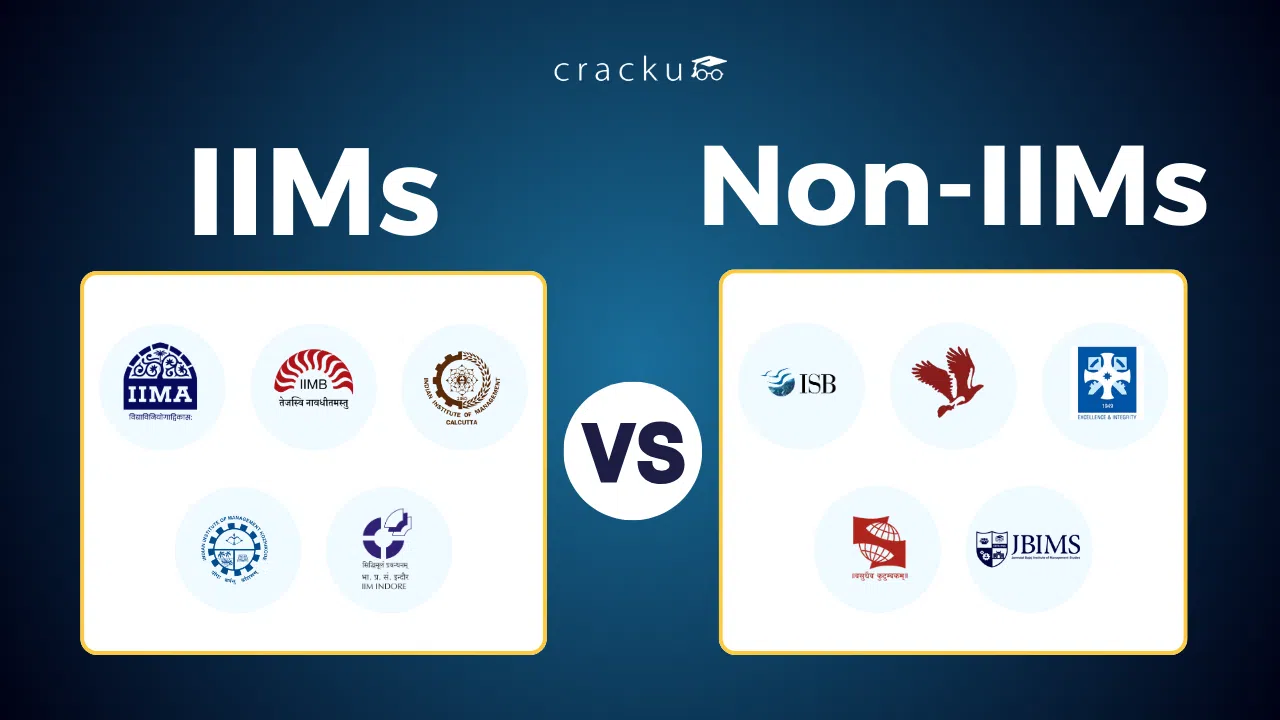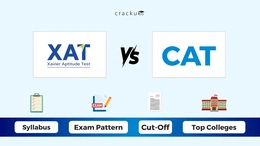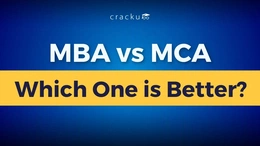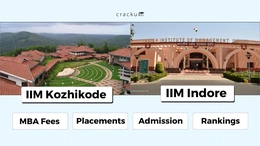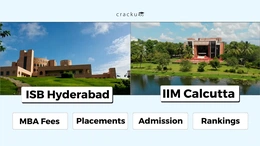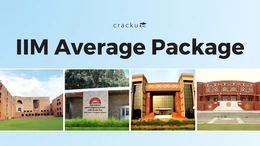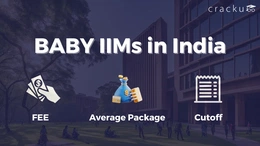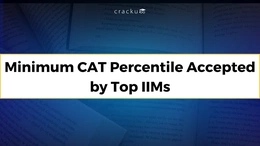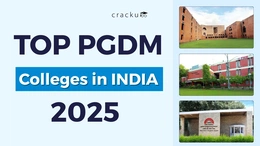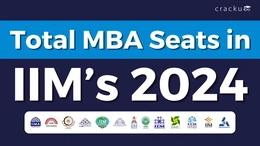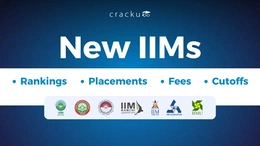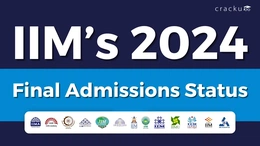IIMs vs Non IIMs MBA Colleges: When it comes to studying for an MBA in India, the real challenge for aspirants is deciding between going into the hallowed corridors of India's prestigious IIM colleges or into any of the other famous non-IIM MBA colleges. While IIMs always stand for excellence and global recognition, other top-notch non-IIMs like XLRI, FMS, and ISB have proved their mettle into rendering exceptional programs and effective placements.
This blog will be about IIMs vs Non-IIMs, with due comparisons among them regarding important matters such as academic structure, placements, fees, rankings, admission, etc. Knowing these differences will put aspirants in a better position to make the right decision concerning their career aspirations.
Also Read, Top MBA Colleges In India Based On Placement Reports 2025
IIMs vs Non-IIMs MBA Colleges: Overview
Below is a detailed comparison of Indian Institutes of Management (IIMs) and top non-IIM MBA colleges based on key aspects like admission criteria, fees, placements, and student diversity.
| Aspect | IIMs | Non-IIMs |
|---|---|---|
| Prestige & Brand | Globally recognized; top-ranked in NIRF and international rankings. | Highly reputed but not as globally recognized (e.g., XLRI, FMS). |
| Admission Criteria | CAT percentile: 90-99.9 for General category. | CAT percentile: 80-98 for General category. |
| Fees | INR 17-25 lakhs for full-time MBA programs. | INR 8-30 lakhs, depending on the institution. |
| Average Placement Package | INR 25-35 LPA at top IIMs like Ahmedabad, Bangalore, Calcutta. | INR 25-30 LPA at top non-IIMs like XLRI, FMS, MDI Gurgaon. |
| Industry Connections | Extensive global and domestic industry ties; strong alumni network. | Good connections, but slightly less extensive compared to IIMs. |
| Student Diversity | Highly competitive pool; diverse academic and professional backgrounds. | Diverse crowd with regional insights; slightly less competitive pool. |
| Specialized Programs | Offers general MBA and niche courses (e.g., Business Analytics, HR). | Specialized programs in HR, Marketing, and Analytics (e.g., XLRI HR). |
Also Read, Top 10 MBA Colleges in India With Fee Structure, Check Now
IIMs vs Non-IIMs: Ranking
The following table presents the rankings of top IIMs and notable non-IIM institutions based on various sources, showcasing their positions in the competitive landscape of management education in India.
Note: The rankings above are sourced from the IIRF MBA Rankings 2024.
Also Read, Private MBA Colleges In India: Placements, Fees, Rankings
IIMs vs Non-IIMs: Admission Process
The admission processes for IIMs and non-IIM institutions differ significantly, particularly in their selection criteria and stages. Below is a comparative overview of the admission processes for both categories.
| Aspect | IIMs | Non-IIMs |
|---|---|---|
| Entrance Exam | Common Admission Test (CAT) is mandatory. | Varies; some may accept CAT, XAT, GMAT, or their own entrance exams. |
| Eligibility Criteria | Bachelor's degree with minimum 50% marks (45% for reserved categories). | Generally similar; may vary by institution. |
| Stage 1: Shortlisting | Candidates are shortlisted based on CAT scores and academic records. | Candidates are shortlisted based on entrance exam scores and sometimes academic performance. |
| Stage 2: WAT/PI | Shortlisted candidates must take the Written Ability Test (WAT) and Personal Interview (PI). | May have a Group Discussion (GD) or Personal Interview (PI) depending on the institution. |
| Stage 3: Final Selection | Final selection is based on a composite score that includes CAT score, WAT/PI performance, academic performance, work experience, and diversity factors. | Final selection often considers entrance exam scores, interview performance, and academic records. |
| Diversity Considerations | Points awarded for gender diversity and academic diversity (non-engineering backgrounds). | Some institutions may consider diversity but often less formally than IIMs. |
Key Insights:
- IIMs have a more structured and rigorous admission process which focuses on CAT examination; other means involve WAT and PI for final selection.
- Non-IIMs totally differ in terms of flexibility entrance examination wise and there may not exist any WAT or GD. This completely depends on the institution.
- Where both look to good academic performance, IIMs focus on a really diverse heterogeneous class through specific scoring systems.
Also Read, IIM Shortlisting Criteria 2025: Composite Score, CAT Percentile
IIMs vs Non-IIMs: Academic Structure
Both are well equipped with the core subjects in their curriculum, for example, Marketing, Finance, Operations, Human Resources, and so on. There is, however, a slight difference.
- IIMs: The curriculum is more rigorous and has lots of focus on case study and practical application. The professors at IIMs have wide experience and qualifications, mostly their PhD or having significant experience in the industry.
- Non-IIMs: Most of the non-IIM universities also provide the students with a decent academic perspective, but it may not have that level of branding and teaching experience like that of the IIM. Some very strong non-IIM, for example, SPJIMR and XLRI, actually compete with the IIM in terms of quality curriculum.
Also Read, Top 20 MBA Colleges In India 2025, Exams, Fees, Placements
IIMs vs Non-IIMs: Placements
Placement statistics indicate that IIMs and non-IIMs differ significantly from each other:
- IIM Placements: The top IIMs report almost all of them securing very high placements, usually attaining 100% placements, with average packages in the range of INR 30-34 lakhs per annum. For example, such placement report of IIM Ahmedabad emphasized the substantial hike of offers received from consulting as well as tech companies.
- Non-IIM Placements: Most other non-IIM institutes also provide placement on this line, but the average salary packages are relatively lower. For example, the best and most famous non-IIM B-schools can offer packages which are competitive in numbers, but generally don't reach the heights of the top IIMs. FMS Delhi is the best non-IIM whose placement stats are up to IIM-A/B/C standards.
Also Read, Affordable MBA Colleges In India With Low Fees 2025, Check Now
IIMs vs Non-IIMs: Fee Structure
The fee structures for IIMs and non-IIMs vary significantly:
| Institution Type | Average Fees (INR) |
|---|---|
| Old IIMs | 25-27 lakhs |
| New IIMs | 17-20 lakhs |
| Top Non-IIMs | 20-30 lakhs |
| Other Non-IIMs | 8-15 lakhs |
IIM entails not only tuition and hostel fees but also other charges, for instance, international immersion programs. While some of these non-IIMs are cheaper, they don't provide a strong industry connectivity or placement grid as others.
Also Read, MBA Placements 2025, MBA Colleges With 100% Placements
IIMs vs Non-IIMs MBA Colleges: Conclusion
While both IIMs and non-IIM institutions offer valuable management education, there are notable differences in academic rigor, placement opportunities, and fee structures. That is one important point required to weigh up by the students while choosing their paths in management education. Ultimately, this may boil down to a personal choice based on career aspirations, financing differences, and particular strengths in every institute.
Also Read, MBA Fees In India 2025, Top MBA Colleges With Course Fees
